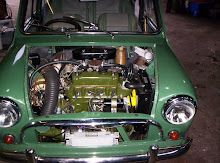The static setting should be regarded only as the starting point for a series of road tests during which the timing can be precisely adjusted by the micrometer control on the distri¬butor, to suit the condition of the engine and the fuel that will normally be used. It is often recommended that the timing should be progressively advanced until the engine just shows signs of pinking under full throttle on a moderately steep hill. While this method gives quite good results with "regular" and "mixture" fuels, however, some premium fuels have such high anti-knock values that the possibility of over-advancing the engine before pinking occurs cannot be ruled-out.
The method favoured by tuning enthusiasts is to make a series of tests on a level road. Note carefully, by stop-watch readings, the time taken to accelerate from 20 m.p.h. to 40 m.p.h. in top gear, with the throttle fully open in each case and over the same stretch of road, so that each test is conducted under precisely similar conditions. The best ignition setting is that which results in the shortest time to accelerate over the speed range. This will also give the most economical fuel consumption.
Alternatively, start each test from a given point and note the point at which the higher speed is reached, by reference to bushes by the roadside, fencing posts or similar identifying marks.
When altering the timing by the roadside, turn the micrometer adjuster only three or four clicks at a time.
Thursday, 15 October 2009
Checking the Timing on the Road
Posted by Info Mini Cars at 02:37
Subscribe to:
Post Comments (Atom)


0 comments:
Post a Comment